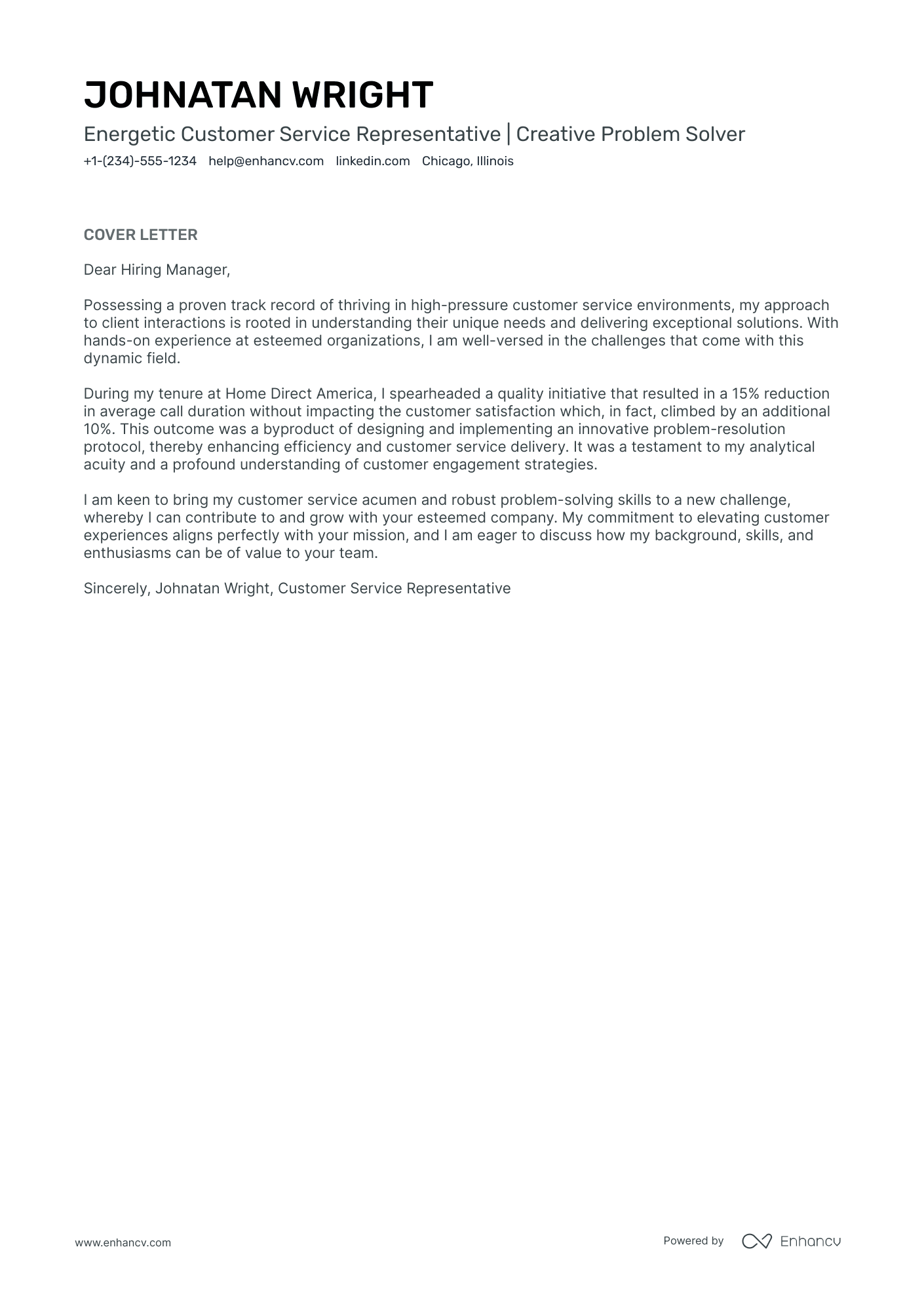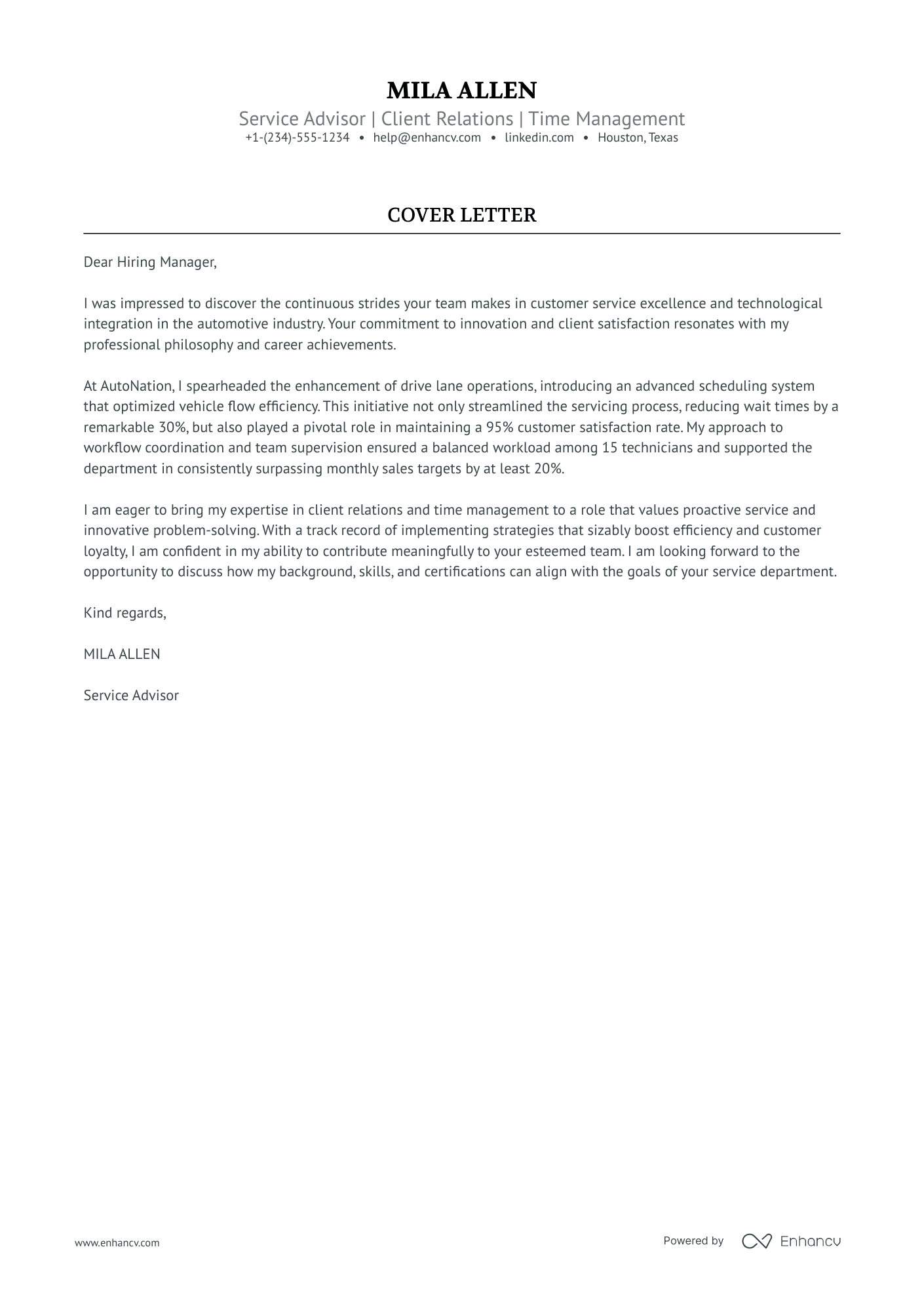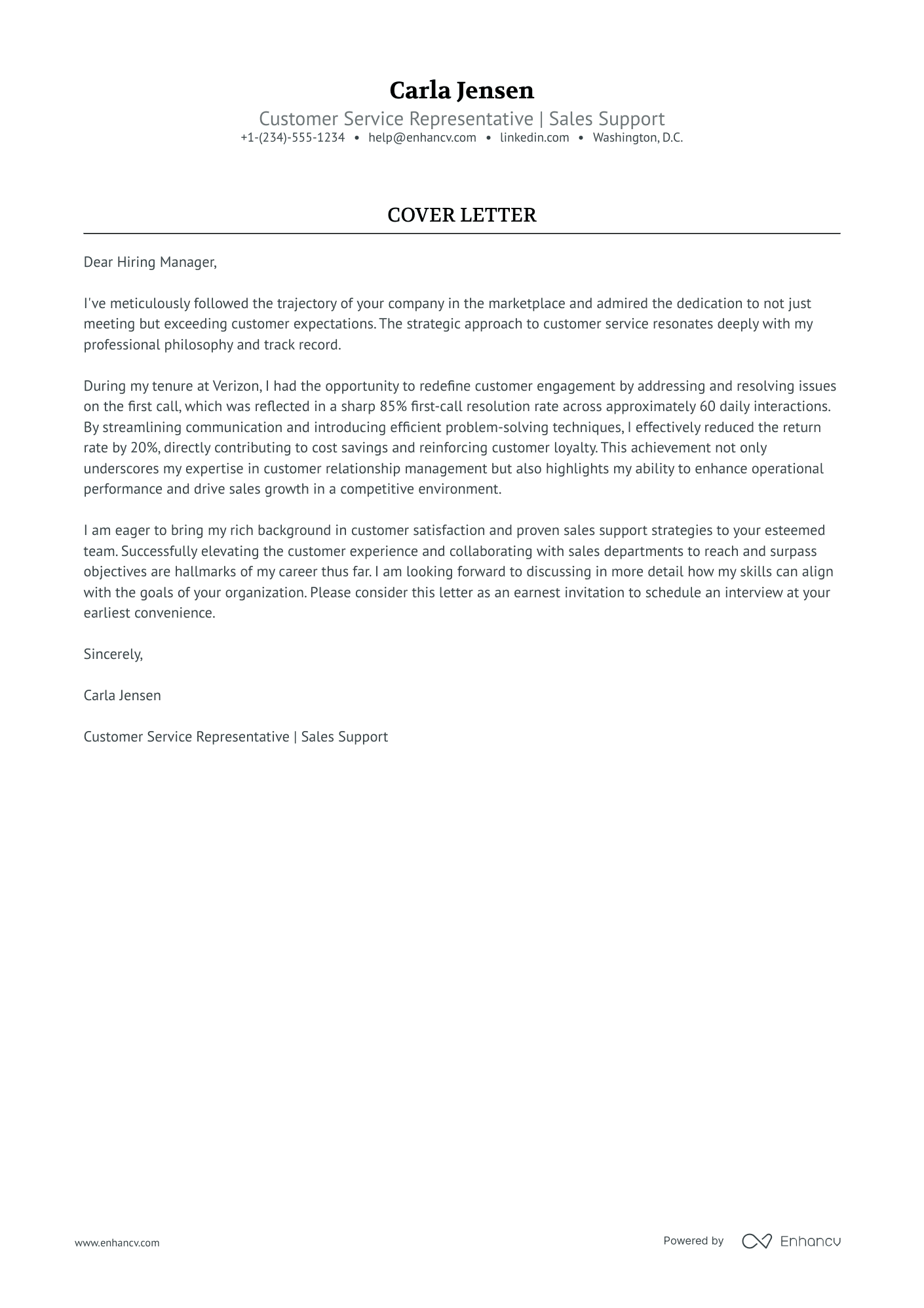Embarking on your job hunt, you've discovered the need for a compelling customer service cover letter—a task that may seem daunting at first glance. Understandably, you want to avoid rehashing your resume and instead spotlight your shining professional moment. Striking the perfect balance between formality and authenticity without falling into the trap of clichés can be tricky, and remembering to keep it concise within a single page adds another layer of challenge. Let's tackle these hurdles together to craft a cover letter that stands out.
- Personalize the greeting to address the recruiter and your introduction that fits the role;
- Follow good examples for individual roles and industries from job-winning cover letters;
- Decide on your most noteworthy achievement to stand out;
- Format, download, and submit your customer service cover letter, following the best HR practices.
Use the power of Enhancv's AI: drag and drop your customer service resume, which will swiftly be converted into your job-winning cover letter.
If the customer service isn't exactly the one you're looking for we have a plethora of cover letter examples for jobs like this one:
Drop your resume here or choose a file.
PDF & DOCX only. Max 2MB file size.
Customer service cover letter example
Mila Allen
Austin, Texas
+1-(234)-555-1234
help@enhancv.com
- Address the company's ethos directly to show an understanding of and alignment with their values, which in this case, is a commitment to service excellence and innovative customer satisfaction.
- Include quantifiable achievements from past roles, such as the 25% increase in team efficiency and 10% elevation in punctuality for on-time departures, to provide concrete evidence of the candidate's impact and abilities.
- Emphasize leadership skills and the ability to effectively manage large teams, as demonstrated by overseeing 30 agents, which is pertinent for the role of a supervisor or manager.
- Express eagerness to bring specific proficiencies to the new role, showing intent to replicate past successes and contribute positively to the prospective employer's operations.
Structuring and formatting your customer service cover letter
Here's what the structure of your customer service cover letter should include:
- Header (with your name, the position you're applying for, and the date);
- Salutation (or greeting);
- Introductory paragraph (or your opening statement);
- Body paragraph (or further proof of your experience);
- Closing paragraph (with a call to action);
- Signature (that is optional).
Use the same font for your customer service resume and cover letter - modern fonts like Lato and Rubik would help you stand out.
Your customer service cover letter should be single-spaced and have a one-inch margins - this format is automatically set up in our cover letter templates and our cover letter builder.
When submitting your cover letter, always ensure it's in PDF, as this format keeps the information intact (and the quality of your document stays the same).
On one final note - the Applicant Tracker System (ATS or the software that is sometimes used to initially assess your application) won't read your customer service cover letter.
Cut down the time spent on cover letters. Use our free cover letter generator to create one in seconds.
The top sections on a customer service cover letter
- Header: This includes your contact information, the date, and the employer's contact information, establishing professionalism and making it easy for the recruiter to get in touch with you.
- Greeting: A personalized greeting to the hiring manager demonstrates that you have taken the time to research who is in charge of hiring and sets a respectful tone for the cover letter.
- Introduction: An engaging opening that addresses your enthusiasm for customer service sets the stage for demonstrating your passion for helping others and creating positive interactions.
- Body: This section should highlight your relevant experience, specific skills in handling customer inquiries and issues, and examples of when you provided exceptional service, showcasing your qualifications for the customer service role.
- Closing: A strong closing that reiterates your interest in the position and your eagerness to discuss how you can contribute to the company's customer satisfaction goals encourages the recruiter to move forward with your application.
Key qualities recruiters search for in a candidate’s cover letter
- Empathy and understanding: Demonstrates the ability to relate to customers' feelings and perspectives, crucial for addressing concerns and creating a positive experience.
- Strong communication skills: Essential for clearly and effectively conveying information, resolving issues, and ensuring customer satisfaction.
- Problem-solving prowess: Indicates the capacity to think on one's feet and devise solutions to customer issues, enhancing service quality.
- Patience and resilience: Reflects the ability to handle difficult situations and maintain composure under pressure, leading to better customer interactions.
- Experience with CRM systems: Shows familiarity with customer relationship management software, which is important for tracking customer interactions and history.
- Proven track record of customer satisfaction: Evidence of successfully meeting or exceeding customer service metrics or goals indicates a commitment to service excellence.
How to personalize your customer service cover letter greeting
Before you start writing your customer service cover letter, take the time to find out who is recruiting for the role.
Search for the recruiter's name on LinkedIn or the corporate website to address them personally in your customer service cover letter salutation.
What if you can't find out who's recruiting for the role?
Always aim to avoid the very impersonal "Dear Sir/Madam" - instead, opt out for "Dear HR Team" or "Dear Hiring Manager" to make a better first impression.
List of salutations you can use
- Dear Hiring Manager,
- Dear [Company Name] Team,
- Dear [Department Name] Head,
- Dear Mr./Ms. [Last Name],
- Dear [Job Title] Search Committee,
- Dear [Full Name],
Get creative with your customer service cover letter introduction
Recruiters are going to assess plenty of candidate profiles for the role. Thus, anything you do to stand out will win you brownie points.
Use your customer service cover letter introduction to share something memorable about your experience.
But before you go down the rabbit hole of creativity and humor, align your message with the company culture.
For example, if you are applying for a role in some startup, use those first two sentences to tell a funny story (about your experience) to quickly connect with the recruiter.
How to select your best achievement for the middle, or the customer service cover letter body
You probably feel exhausted by this point in your application: you've dived into all the details of your success and skills in your customer service resume.
What else can you include in your customer service cover letter body?
Well, for starters, the next three to six paragraphs should show you further value as a professional. Or, why should recruiters choose you?
Think back on a noteworthy achievement that answers key job requirements and dive deep.
Structure your customer service cover letter middle as you'd a story: following chronological logic and highlighting outcomes, thanks to skills.
At the end of the day, you'd want recruiters to be able to see you as the best candidate for the role and understand more about who you are and what makes your success unique (and valuable to the role).
Closing remarks to end your customer service cover letter
Of course, you'll have to show gratitude to the recruiters, who have assessed your profile at the end of your customer service cover letter .
A "Thank you for the consideration" would work wonders, instead of the standard "Sincerely yours".
Do you want to make an even better impression?
Close off your customer service cover letter by promising how you see yourself excelling in the role and the positive impact you'd bring about.
A sentence that encourages some further action on the recruiter's end could also be a good way to close off the communication (e.g. provide your availability for an interview).
What to write on your customer service cover letter, when you have zero experience
The best advice for candidates, writing their customer service cover letters with no experience, is this - be honest.
If you have no past professional roles in your portfolio, focus recruiters' attention on your strengths - like your unique, transferrable skill set (gained as a result of your whole life), backed up by one key achievement.
Or, maybe you dream big and have huge motivation to join the company. Use your customer service cover letter to describe your career ambition - that one that keeps you up at night, dreaming about your future.
Finally, always ensure you've answered why employers should hire precisely you and how your skills would benefit their organization.
Key takeaways
Within this Enhancv guide, we've provided you with plenty of advice and inspiration on writing your customer service cover letter:
- Always make sure your customer service cover letter is tailored to the role you're applying for to make a good impression on recruiters;
- In your customer service cover letter include a header (with your name, the role you're applying for, date, and contact details) and an introduction of up to two sentences that highlight your key accomplishment or why you'd fit the role;
- Focus your customer service cover letter body on one sole achievement through your career and all the valuable lessons, skills, and know-how you've learned (that are relevant to the role);
- Ensure your customer service cover letter closing statement isn't generic and includes either a call to action or a promise;
- If you lack professional experience, shift recruiters' focus to a relevant achievement (thanks to your academic or versatile experience) or toward your dreams and goals for professional growth.
Customer Service cover letter examples
By Experience
Entry-Level Customer Service
By Role

























